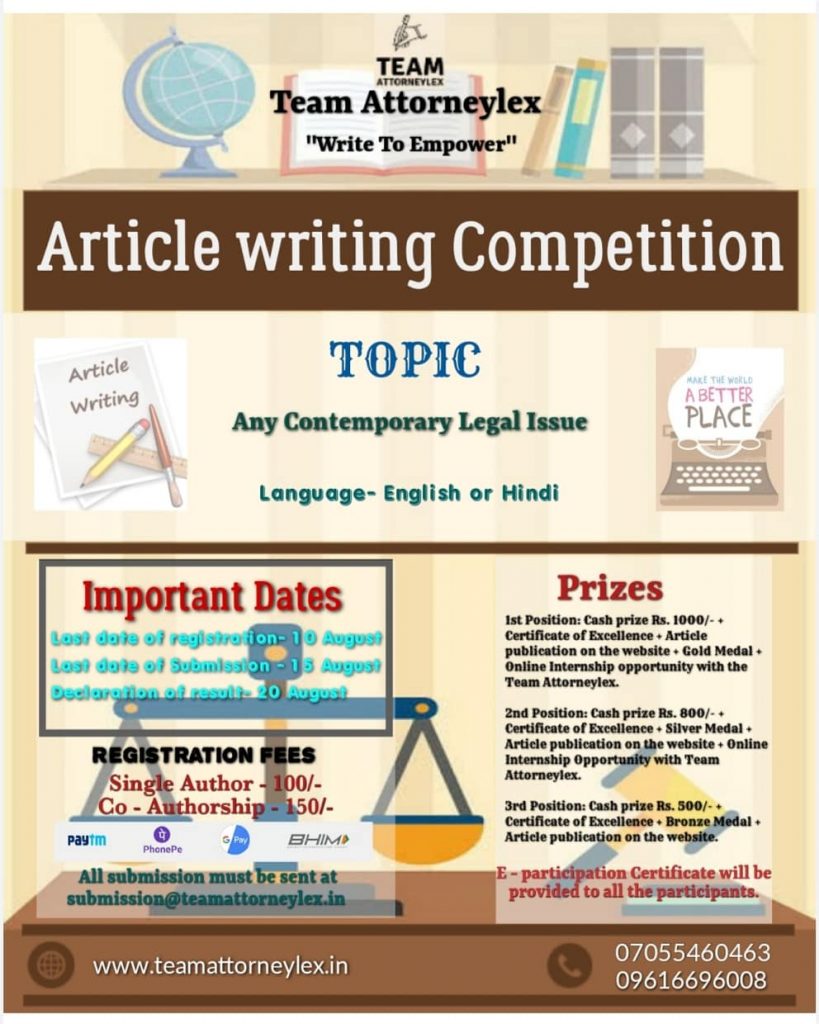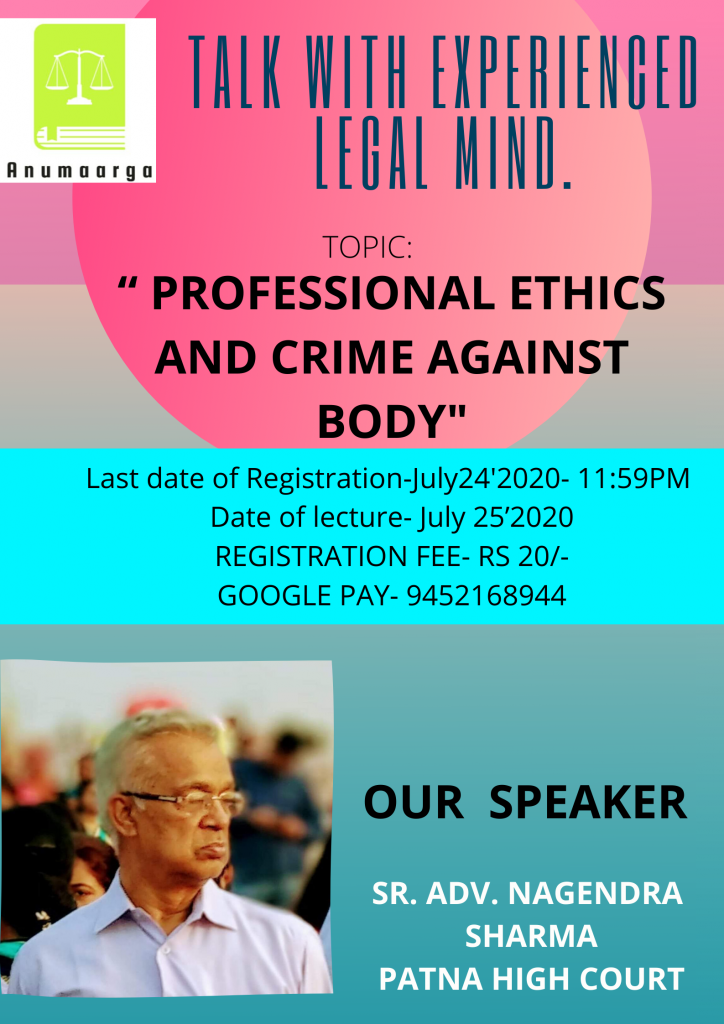This article is written by Siddhi P. Nagwekar, a student of Karnataka State Law University’s Law School. This article deliberates on The Bar of Limitation on Torts, what it entails, its relevance, and the related statutes in India, the US, and the UK.
A brief idea on ‘Bar of Limitations’
Limitation means a legally specified time after which an action could be defeated or the ownership doesn’t persist. The Limitation Act, 1963[1] determines[2] duration of limitation. The period fixed for any suit, appeal or application by the Schedule, and “prescribed period” means the amount of limitation computed following the provisions of this Act.
Let us consider a hypothetical case where A gives a loan of 5 lakh rupees to B for two years after which B is to return the same to A. After this period lapses, there are two courses of actions that may follow:
a. B pays back the sum of money; or
b. B refuses/ doesn’t pay back the sum lent
In the first occurrence, there is no complication because the agreement between the two parties has been met with, but within the second case in point, B has dishonoured the agreement in question.
An ancient Roman maxim states Ubi jus, ibi remedium meaning ‘Where there’s a right, there’s a remedy’. Considering this principle, A has a remedy for his right of procuring his refund from B, binding him by the obligation.
The Limitation Act, 1963 for the balance outstanding on a mutual, open, and current account, where there are corresponding demands between the parties, sets out a provision for three years. This three-year period starts at the close of the year during which the last item admitted or proved is entered in the account; such year to be computed as within the account.[3]
Now, if A fails to do so within the given ‘limitation bar’ that’s three years for this case, A deprives himself the right to remedy, essentially meaning the right to bring legal action against B has ended.
The Supreme Court has given a concurrent ruling in the case of Rajender Singh & Ors vs Santa Singh & Ors. [4]. The apropos paragraph of the judgment reads:
“The policy inherent to statutes of limitation, spoken of as statutes of ” repose” or of “Peace”, has been thus stated in Halsbury’s Laws of England Vol. 24, p. 181 (para 130) “330. Policy of Limitation Acts. The courts have expressed a minimum of three differing reasons supporting the existence of statutes of limitation, namely, (1) that long-dormant claims have more of cruelty than justice in them, (2) that a defendant might have lost the evidence to refute. a stale claim, and (3) that persons with valid grounds of actions should follow them with reasonable care.” The goal of the law of limitation is to put a stop to disturbance or deprivation of what may have been obtained in equity and justice by lasting enjoyment or what may be are lost by a party’s own passivity, negligence, or laches.”
After this case in 1973, fast-forward to a quarter-century later, there came the judgment of N Balakrishnan vs M. Krishnamurthy[5], germane to the theme in hand. It bolstered the stance of the judiciary on the bar of limitations and emphasized its relevance:
“Rule of limitation aren’t meant to deface the right of parties. They’re meant to ascertain that parties don’t resort to dilatory tactics, but look for their remedy promptly. the intent of providing a legal remedy is to repair the damage caused by reason of legal injury/legal rights violation. Law of limitation fixes a lifespan for such legal remedy for the redress of the wrong so suffered. Time is precious and therefore the wasted time would never revisit. During the course of time, newer causes would sprout up necessitating newer persons to look for legal remedy by approaching the courts. So, a life must be fixed for each remedy. The unending period for launching the remedy may possibly cause unending uncertainty and consequential anarchy. The Law of limitation is thus founded on public policy. It’s enshrined within the maxim ‘Interest reipublicae up sit finis litium’ (it is for the overall welfare that a period is put to litigation). The motive is that each legal remedy must be kept alive for a legislatively set period of time.”
It is quite clear from the above-mentioned judgments what the bar of limitation entails.
The aims behind statutes of limitation are that of discouraging old and deceitful claims, and that of allowing estimable claimants, who are as careful as possible, a chance to be on the lookout for redress for injuries suffered. Any person seeking relief for injury was to have brought his claim within the period stated in the statute or be barred.
Starts and Stops- Accrual of the Cause of Action
To know the extent of the limitation period is not going to play out in your favour if you don’t know when that period starts to run. There are two vital points. The primary is when the cause of action first ensues. When that is will depend upon different causes of action, for tort, it’s the purpose of injury, even where that damage could also be initially minor and unapparent. When we look at the case of claims for a debt, acknowledging the existence of the debt will restart the limitation period.
The second key point is that the point at which loss could have been reasonably discovered. As is noted above, it may apply in many cases of tort and restitution.
The Bar of Limitation on Torts
Limitation periods for various torts are found on the objectives that a tort claim sought to realize besides the gravity of the particular tort in question. The remedy for breach of duty in tort is ordinarily a claim for damages, though equitable remedies also are available in appropriate cases. The key aim of tort is taken to be compensation for harm suffered as results of the breach of an obligation fixed by law. Tort seems to put greater emphasis on wrongs of commission instead of wrongs of omission. Another important aim of tort is to discourage behaviour which in good probability to cause harm.
India
Part VII of the Schedule of Limitations Act, 1963 lays down the limitation periods for torts. It gives out a table of torts, from point 71 to 92, entailing the outline of the suit, period of limitation, and time from which period begins to run. This is the single Act that provides the authority, legitimacy and aiming to match the thought of the idea of Limitation Bars in India. It’s still in the evolving stage as and when the cases appear around it.
Under English Law
The Limitation Act allows actions for breach of contract and tort, like negligence, to be brought within six years, where the loss wasn’t apparent at the time of the tort there’s an alternate period of three years from the date on which loss could reasonably are discovered; Considering the case of fraud, the amount of limitation doesn’t commence at all until the claimant has or could reasonably have discovered the fraud;[6]
Additionally, the three-year period is given as the special deadline for personal injury actions.
The three-year period begins to run from
(a) the date on which the cause of action arose; or
(b) the date on which the injured person becomes aware (if later).
The final question on limitation is what happens when the amount of time expires without proceedings being issued. The pivotal distinction that springs up here is: does the expiry of the limitation period simply act as a bar to seeking a remedy before the courts or does it exterminate the interest protected as the right altogether? This is not based sheerly on connotations. If a defendant can assert his right in a way other than bringing a claim, most obviously by way of asserting a set-off, then that right will still have value even where the remedy is time-barred. If the right is extinguished altogether, there is hardly left anything to say. The approach adopted by English law will depend upon the character of the claim. Talking about the case of contract[7] and most torts aside from conversion[8] only the remedy is barred. In cases concerning title to the recovery of land[9] or personal estate[10], or arising under the Consumer Protection Act 1987[11] it is the right itself that gets extinguished.
Under US Law
Under 46 U.S. Code § 30106, “Except as otherwise provided by law, a legal proceeding for damages for private injury or death arising out of a maritime tort must be brought within 3 years after the explanation of action arose.” There are some exceptions to it at present, primarily concerning Jones Act cases filed against the government, during which case the statute of limitations are often but 2 years.[12]
Every state has adopted its statute of limitations, which demands any personal injury suit be filed in court within a fixed time after the incident or injury. The defined limit prescribed by each state ranges from one year (in Kentucky and Tennessee) to 6 years (in Maine and North Dakota).
The “Discovery of Harm” Rule
While a statute of limitations may assert that a private injury lawsuit must be filed within a particular amount of time after an accident or injury, that period usually doesn’t begin to run until the instant when the person filing suit knew (or should reasonably have known) that they had suffered harm and therefore the nature of that harm.
An example of this “discovery of harm” rule may be a medical malpractice claim during which a surgeon mistakenly left a short-lived bandage inside the abdomen of a patient, but the error wasn’t discovered until years later, during another surgery. In such a case, the patient had no reason to understand what happened and this lack of data couldn’t be called unreasonable under the circumstances. Presumably, the statute of limitations wouldn’t begin to run until the day on which the primary surgeon’s mistake was “discovered” by the patient, instead of from the day on which the primary surgeon committed the error.
It is important to bear in mind that the delay in discovery must be one that’s reasonable under the circumstances. So, if the patient given in the above example was experiencing abdominal pain after the primary surgery but refused to find medical treatment for several years, his or her lawsuit may fairly be barred by the statute of limitations. Also, the “discovery of harm” rule will seldom arise within the commonest sorts of injury claims — those after car accidents and slip and fall incidents. This is often because such occurrences usually leave nothing to “discover” in terms of the source and nature of any harm suffered.
However, the discovery rule may apply in some death cases wrongfully.
Conclusion
Statutes of limitation reflect the policy of protecting defendants from stale and fraudulent claims. The implementation of the statutes doesn’t depend on the existence of a stale or fraudulent claim, but rather upon the amount of years laid out in the applicable statute. Statutes of limitation weigh conflicting public policies. As a result, some plaintiffs are going be denied recovery notwithstanding the severity of their injury.
[1] Enacted on 1st January, 1964, vide notification No. S.O. 3118, dated 29th October, 1963, see Gazette of India, Part II, sec. 3 (ii). Amended in West Bengal by W.B. Act 18 of 1977.
Enforced on 1st September, 1984, vide notification No. S.O. 647(C), in respect of the State of Sikkim dated 24th August, 1984, see Gazette of India, Part II, sec. 3(ii).
[2] See Sec 2(j) of Limitations Act, 1963
[3] See Supra text accompanying note 2: The Schedule (Periods of Limitation)Part I- Suits Relating to Accounts.
[4] (1973) 2 SCC 705
[5] (1998) 7 SCC 123
[6] Section 2, 14A and 32 of the Limitation Act, 1980, Available at: <http://www.legislation.gov.uk/ukpga/1980/58/contents>
[7] Royal Norwegian Government v Constant & Constant [1960] 2 Lloyd’s Rep 431.
[8] C&M Matthews Ltd v Marsden Building Society [1951] Ch 758.
[9] Limitation Act section 17.
[10] Limitation Act sections 3-4.
[11] Consumer Protection Act 1987 section 11A(3).
[12] “33 U.S. Code § 913 – Filing of claims”. Legal Information Institute. Cornell Law School. Retrieved 09 July 2020.
Latest Posts
- Job opportunity at EXO Edge, Sahibzada Ajit Singh Nagar, Punjab, India: Apply Now!!
- Internship opportunity at Vishwas Advisors, Kalyan, Maharashtra, India: Apply Now!!
- Internship opportunity at Kulfi Collective, Mumbai, Maharashtra, India: Apply Now!
- Job opportunity at The Neotia University, Diamond Harbour, West Bengal, India: Apply Now !!
- Job opportunity at Morgan Stanley, Mumbai, Maharashtra, India: Apply Now!!
- Job opportunity at VISA INTELLIGENCE CONSULTANCY LLP, New Delhi, Delhi, India: Apply Now!!
- Job opportunity at Amazon Web Services (AWS), Gurugram, Haryana, India: Apply Now!!
- Job opportunity at Stelcore Management Services Private Limited, Mumbai, Maharashtra, India: Apply Now!!
- Job opportunity at Zscaler, Sahibzada Ajit Singh Nagar, Punjab, India: Apply Now!!
- Job opportunity at Irish Expert, Delhi, India: Apply Now!!
- Job opportunity at UnitedLex · Gurgaon, Haryana, India: Apply Now!
- Internship opportunity at Vineforce · Nabha, Punjab, India: Apply Now!!
Archives


